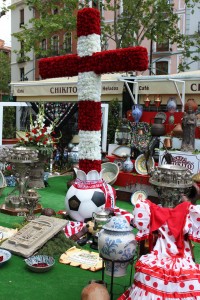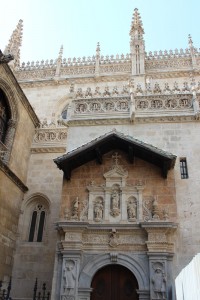
Following on from my post about Granada’s Carthusian Monastery, my second mission on my visit to Granada last Friday was to visit La Capilla Real, the Royal Chapel, where Ferdinand II of Aragon, Isabella I of Castile, Joanna of Castile and Philip I (Philip the Handsome) are buried.
It was a wonderful day to visit Granada because it was also the Fiesta de las Cruces (Festival of the Crosses) so the city was full of plazas decorated with floral crosses and everyone was dressed in flamenco garb – beautiful! Even women dressed in business suits for work had a flower pinned in their hair and children in pushchairs were wearing flamenco suits or dresses! Every now and then the traffic would stop for groups of men in Flamenco suits and hats on horseback – I do love Spain!
Anyway, back to the Capilla Real, the Royal Chapel which is famed for being the resting place of Los Reyes Católicos (the Catholic Monarchs), Ferdinand and Isabella, or Fernando and Isabel as the Spaniards refer to them. Those of you who have visited the Alhambra, the Moorish palace, in Granada will know that Ferdinand and Isabella were responsible for taking Granada from the Moors in 1492. The 16th century monarchs, therefore, have a very special place in the hearts of the people of Andalucia, Spain, and there are many public place and buildings named after them. Those of you who are interested in Catherine of Aragon, or Cataline de Aragón as she’s known in Spain, will be interested to know that Catherine of Aragon’s home was Granada (the Alhambra palace) before she set sail for England in 1501 to marry Arthur, Prince of Wales.
Photography was not allowed in the chapel itself, although it would have been impossible to photograph the effigies on the tombs anyway because they tombs stood much taller than me. You would have needed scaffolding or a ladder to take a proper photo so I bought postcards. What I found fascinating was that there were steps to go down into the floor beneath the effigies and there was a window cut into it so that you could see their actual coffins in the crypt. It was quite moving to see a posy of flowers, the 16th century wooden crucifix and the four ancient wooden coffins of Fernando, Isabel, Juan and Felipe El Hermoso (Philip the Handsome).
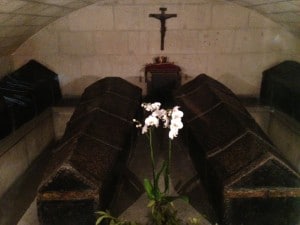
Here are some facts about the Capilla and Ferdinand and Isabella:
- Granada became part of the Kingdom of Castile under Ferdinand and Isabella.
- Isabella and Ferdinand are known for uniting all Spanish states under one monarchy and also linking Spain to Portugal, England and Austria through arranged marriages.
- The conquest of Granada and the defeat of the Moors led to the expeditions of Christopher Columbus which, in turn, opened up the New World. This is why 1492 is seen as the start of the beginning of the Modern Era in history.
- Granada became the centre, or capital, of the reign of the Catholic monarchs.
- The Capilla Real was founded as the mausoleum of Ferdinand and Isabella by Royal Warrant on 13 September 1504. Construction began in 1506 and the chapel was completed in 1517.
- The tomb of Ferdinand and Isabella was sculpted in 1517 by Italian Domenico Fancelli. Bartolomé Ordóñez was responsible for the tombs of Juana and Felipe which dates to 1520.
- The sacristy museum houses the Royal Warrant commissioning the building of the chapel, tapestries, Isabella’s crown and sceptre, Ferdinand’s sword, liturgical items and personal items belonging to Isabella (Gothic altar cross, chalice, peace-offering, chalice, girdle, rosary and mirror. The Queen’s Missal, a work on vellum by Francisco Flores (1496), is also on display, as is a statue of St Catherine.
- The Capilla is home to a collection of paintings which once belonged to Isabella – Artists include Botticelli, Perugino, Berrugueti and Bermejo.
- The Passion Altarpiece was made by Jacob Florentino in 1521 and on each side of it are carvings by Felipe Vigarny of Ferdinand and Isabella kneeling in prayer.
- The outside of the Capilla features crestings with the repeated letters of “F” and “Y” for Ferdinand and Isabella/Ysabel.
- The Capilla is still a place of worship where the Eucharist is celebrated on a daily basis.
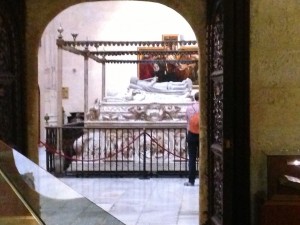
The following prayer features in the leaflet I was given as I entered the Capilla:
“We give you thanks, Lord,
for all that Queen Isabel
did for the Catholic faith,
for her family life,
and governing actions,
that were always
inspired and sustained by an
intense spiritual life.
We wish that she serve
an inspiration, and we wish
that her example of wife and
mother,
of woman
and Christian governess,
serve as guide.
We supplicate, Lord,
that if You issue it
and that it serve
for the good of man,
that her virtues be recognized
by the Church
and that we venerate her publicly
and ask for her intercession
before you. Amen.”
I’m just about to watch the first season of “Isabel”, the Spanish TV series about Isabella of Castile, which I bought on DVD as I missed too much of it on TV. It’s supposed to be excellent and is up for some awards so I’m looking forward to getting ‘stuck in’. It’s only available in Spanish with Spanish subtitles at the moment, but if you speak Spanish then it will definitely be worth you getting hold of.
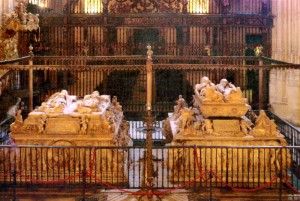
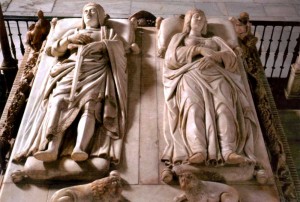
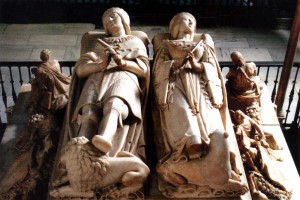

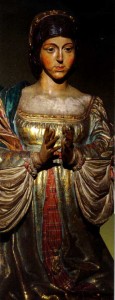
For those of you interested in the Fiesta of the May Crosses:

